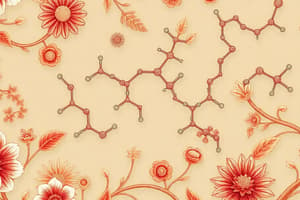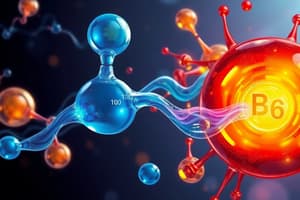Podcast
Questions and Answers
Name the 18 functional groups
Name the 18 functional groups
Alkyl halide, Alkene, Alkyne, Alcohol, Ether, Thiol, Sulfide (thioether), Aromatic ring, Ketone, Aldehyde, Carboxylic acid, Acid chloride, Ester, Amide, Amine, Nitrile, Nitro, Acetal
What is an Alkyl Halide?
What is an Alkyl Halide?
Alkyl halide
What is an Alkene?
What is an Alkene?
Alkene
What is an Alkyne?
What is an Alkyne?
What is an Alcohol?
What is an Alcohol?
What is an Ether?
What is an Ether?
What is a Thiol?
What is a Thiol?
What is a Sulfide (thioether)?
What is a Sulfide (thioether)?
What is an Aromatic Ring?
What is an Aromatic Ring?
What is a Ketone?
What is a Ketone?
What is an Aldehyde?
What is an Aldehyde?
What is a Carboxylic Acid?
What is a Carboxylic Acid?
What is an Acid Chloride?
What is an Acid Chloride?
What is an Ester?
What is an Ester?
What is an Amide?
What is an Amide?
What is an Amine?
What is an Amine?
What is a Nitrile?
What is a Nitrile?
What is Nitro?
What is Nitro?
What is Acetal?
What is Acetal?
What is an Alkane?
What is an Alkane?
Flashcards
Alkyl Halide
Alkyl Halide
Organic compounds containing a halogen atom (F, Cl, Br, I) bonded to an alkyl group.
Alkene
Alkene
Features at least one double bond between carbon atoms; general formula CnH2n.
Alkyne
Alkyne
Contains at least one triple bond between carbon atoms; general formula CnH2n-2.
Alcohol
Alcohol
Signup and view all the flashcards
Ether
Ether
Signup and view all the flashcards
Thiol
Thiol
Signup and view all the flashcards
Sulfide (Thioether)
Sulfide (Thioether)
Signup and view all the flashcards
Aromatic Ring
Aromatic Ring
Signup and view all the flashcards
Ketone
Ketone
Signup and view all the flashcards
Aldehyde
Aldehyde
Signup and view all the flashcards
Carboxylic Acid
Carboxylic Acid
Signup and view all the flashcards
Acid Chloride
Acid Chloride
Signup and view all the flashcards
Ester
Ester
Signup and view all the flashcards
Amide
Amide
Signup and view all the flashcards
Amine
Amine
Signup and view all the flashcards
Nitrile
Nitrile
Signup and view all the flashcards
Nitro
Nitro
Signup and view all the flashcards
Acetal
Acetal
Signup and view all the flashcards
Alkane
Alkane
Signup and view all the flashcards
Study Notes
Functional Groups Overview
- Total Functional Groups: 18 distinct functional groups are recognized in organic chemistry.
- Each functional group possesses unique chemical properties and reactivities.
List of Functional Groups
- Alkyl Halide: Organic compounds containing a halogen atom (F, Cl, Br, I) bonded to an alkyl group.
- Alkene: Features at least one double bond between carbon atoms; general formula CnH2n.
- Alkyne: Contains at least one triple bond between carbon atoms; general formula CnH2n-2.
- Alcohol: Characterized by the presence of a hydroxyl (-OH) group attached to a carbon atom.
- Ether: Composed of an oxygen atom connected to two alkyl or aryl groups (R-O-R').
- Thiol: Contains a sulfur atom with a hydrogen atom (-SH) attached, analogous to alcohols.
- Sulfide (Thioether): Similar to ethers but with sulfur instead of oxygen (R-S-R').
- Aromatic Ring: Contains alternating single and double bonds in a cyclic structure, typically benzene.
- Ketone: Features a carbonyl group (C=O) bonded to two carbon atoms, usually at the middle of the carbon skeleton.
- Aldehyde: Contains a carbonyl group with at least one hydrogen atom attached; found at the end of a carbon chain.
- Carboxylic Acid: Characterized by a carboxyl group (-COOH), making it acidic.
- Acid Chloride: Contains a carbonyl group bonded to a chlorine atom, reactive in acyl substitution reactions.
- Ester: Formed from the reaction of an alcohol and a carboxylic acid; characterized by the RCOOR' structure.
- Amide: Contains a carbonyl group attached to a nitrogen atom; derivatives of carboxylic acids.
- Amine: Composed of nitrogen atoms bonded to carbon atoms or hydrogen; classified based on the number of carbon groups attached.
- Nitrile: Contains a cyano group (-C≡N), characterized by a carbon triple-bonded to a nitrogen atom.
- Nitro: Contains a nitro group (-NO2), typically attached to an aromatic ring or aliphatic carbon.
- Acetal: Formed from the reaction of an aldehyde or ketone with two alcohol molecules, both -O must be bonded to the same carbon.
Additional Notes
- Alkane: Saturated hydrocarbons with single carbon-carbon bonds; no functional groups, general formula CnH2n+2.
Studying That Suits You
Use AI to generate personalized quizzes and flashcards to suit your learning preferences.



